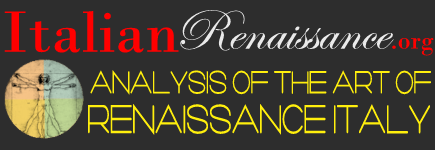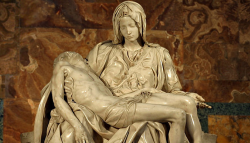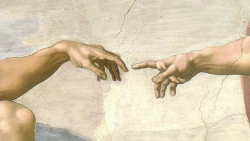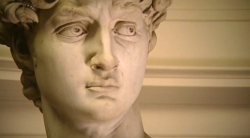From Lives of the Most Excellent Italian Painters, Sculptors, and Architects, by Giorgio Vasari
Life of Gaddo Gaddi (c. 1239 – c. 1312)
Gaddo, painter of Florence, displayed at this same time more design in his works, wrought after the Greek manner, than did Andrea Tafi and the other painters that were before him, and this perchance arose from the intimate friendship and intercourse that he held with Cimabue, seeing that, by reason either of their conformity of blood or of the goodness of their minds, finding themselves united one to the other by a strait affection, from the frequent converse that they had together and from their discoursing lovingly very often about the difficulties of the arts there were born in their minds conceptions very beautiful and grand; and this came to pass for them the more easily inasmuch as they were assisted by the subtlety of the air of Florence, which is wont to produce spirits both ingenious and subtle, removing continually from round them that little of rust and grossness that most times nature is not able to remove, together with the emulation and with the precepts that the good craftsmen provide in every age. And it is seen clearly that works concerted between those who, in their friendship, are not veiled with the mask of duplicity (although few so made are to be found), arrive at much perfection; and the same men, conferring on the difficulties of the sciences that they are learning, purge them and render them so clear and easy that the greatest praise comes therefrom. Whereas some, on the contrary, diabolically working with profession of friendship, and using the cloak of truth and of lovingness to conceal their envy and malice, rob them of their conceptions, in a manner that the arts do not so soon attain to that excellence which they would if love embraced the minds of the gracious spirits; as it truly bound together Gaddo and Cimabue, and in like manner Andrea Tafi and Gaddo, who was taken by Andrea into company with himself in order to finish the mosaics of S. Giovanni, where that Gaddo learnt so much that afterwards he made by himself the Prophets that are seen round that church in the square spaces beneath the windows; and having wrought these by his own self and with much better manner, they brought him very great fame. Wherefore, growing in courage and being disposed to work by himself, he applied himself continually to studying the Greek manner together with that of Cimabue. Whence, after no long time, having become excellent in the art, there was allotted to him by the Wardens of Works of S. Maria del Fiore the lunette over the principal door within the church, wherein he wrought in mosaic the Coronation of Our Lady; which work, when finished, was judged by all the masters, both foreign and native, the most beautiful that had yet been seen in all Italy in that craft, there being recognized therein more design, more judgment, and more diligence than in all the rest of the works in mosaic that were then to be found in Italy.
Wherefore, the fame of this work spreading, Gaddo was called to Rome in the year 1308 (which was the year after the fire that burnt down the Church and the Palaces of the Lateran) by Clement V, for whom he finished certain works in mosaic left imperfect by Fra Jacopo da Turrita. He then wrought certain works, also in mosaic, in the Church of S. Pietro, both in the principal chapel and throughout the church, and in particular a large God the Father, with many other figures, on the façade; and helping to finish some scenes in mosaic that are in the façade of S. Maria Maggiore, he somewhat improved the manner, and departed also a little from that manner of the Greeks, which had in it nothing whatever of the good.
Next, having returned to Tuscany, he wrought in the Duomo Vecchio without the city of Arezzo, for the Tarlati, Lords of Pietramala, certain works in mosaic on a vault that was all made of sponge-stone and served for roof to the middle part of that church, which, being too much burdened by the ancient vault of stone, fell down in the time of Bishop Gentile of Urbino, who had it afterwards all rebuilt with bricks. Departing from Arezzo, Gaddo went to Pisa, where, in the niche over the Chapel of the Incoronata in the Duomo, he made a Madonna who is ascending into Heaven, and, above, a Jesus Christ who is awaiting her and has a rich chair prepared as a seat for her; which work, for those times, was wrought so well and with so great diligence that it has been very well preserved, even to our own day. After this Gaddo returned to Florence, in mind to rest; wherefore, undertaking to make little panels in mosaic, he executed some with egg-shells, with incredible diligence and patience, as can be seen, among others, in some that are still to-day in the Church of S. Giovanni in Florence. It is read, also, that he made two of them for King Robert, but nothing more is known of these. And let this be enough to have said of Gaddo Gaddi with regard to work in mosaic.
In painting he made many panels, and among others that which is in S. Maria Novella, in the tramezzo of the church, in the Chapel of the Minerbetti, and many others that were sent into diverse parts of Tuscany. And working thus, now in mosaic and now in painting, he made both in the one and in the other exercise many passing good works, which maintained him ever in good credit and reputation. I could here enlarge further in discoursing of Gaddo, but seeing that the manners of the painters of those times cannot, for the most part, render great assistance to the craftsmen, I will pass this over in silence, reserving myself to be longer in the Lives of those who, having improved the arts, can give some measure of assistance.
From Giorgio Vasari, Lives of the Most Excellent Italian Painters, Sculptors, and ArchitectsGaddo lived seventy-three years, and died in 1312, and was given honourable burial in S. Croce by his son Taddeo. And although he had other sons, Taddeo alone, who was held at the baptismal font by Giotto, applied himself to painting, learning at first the principles from his father and then the rest from Giotto. A disciple of Gaddo, besides Taddeo his son, was Vicino, painter of Pisa, who wrought very well certain works in mosaic in the principal apse of the Duomo of Pisa, as these words demonstrate, that are still seen in that apse:
TEMPORE DOMINI JOANNIS ROSSI, OPERARII ISTIUS ECCLESIÆ, VICINUS PICTOR INCEPIT ET PERFECIT HANC IMAGINEM BEATÆ MARIÆ; SED MAJESTATIS, ET EVANGELISTÆ, PER ALIOS INCEPTÆ, IPSE COMPLEVIT ET PERFECIT, A.D. 1321, DE MENSE SEPTEMBRIS. BENEDICTUM SIT NOMEN DOMINI DEI NOSTRI JESU CHRISTI. AMEN.
In the Chapel of the Baroncelli, in the same Church of S. Croce, there is a portrait of Gaddo by the hand of his son Taddeo, in a Marriage of Our Lady, and beside him is Andrea Tafi. And in our aforesaid book there is a drawing by the hand of Gaddo, made in miniature, like that of Cimabue, wherein it is seen how strong he was in draughtsmanship.
Now, seeing that in an old book, from which I have drawn these few facts that have been related about Gaddo Gaddi, there is also an account of the building of S. Maria Novella, the Church of the Preaching Friars in Florence, a building truly magnificent and highly honoured, I will not pass by in silence by whom and at what time it was built. I say, then, that the Blessed Dominic being in Bologna, and there being conceded to him the property of Ripoli without Florence, he sent thither twelve friars under the care of the Blessed Giovanni da Salerno; and not many years afterwards these friars came to Florence to occupy the church and precincts of S. Pancrazio, and they were settled there, when Dominic himself came to Florence, whereupon they left that place and went to settle in the Church of S. Paolo, according to his pleasure. Later, there being conceded to the said Blessed Giovanni the precincts of S. Maria Novella, with all its wealth, by the Legate of the Pope and by the Bishop of the city, they were put in possession and began to occupy the said precincts on the last day of October, 1221. And because the said church was passing small and faced westward, with its entrance on the Piazza Vecchia, the friars, being now grown to a good number and having great repute in the city, began to think of increasing the said church and convent. Wherefore, having got together a very great sum of money, and having many in the city who were promising every assistance, they began the building of[Pg 59] the new church on St. Luke’s Day, in 1278; the first stone of the foundations being most solemnly laid by Cardinal Latino degli Orsini, Legate of Pope Nicholas III to the Florentines. The architects of the said church were Fra Giovanni, a Florentine, and Fra Ristoro da Campi, lay-brothers of the same Order, who rebuilt the Ponte alla Carraja and that of S. Trinita, destroyed by the flood of 1264 on October 1. The greater part of the site of the said church and convent was presented to the friars by the heirs of Messer Jacopo, Cavaliere de’ Tornaquinci. The cost, as has been said, was met partly by alms and partly by the money of diverse persons who assisted gallantly, and in particular with the assistance of Frate Aldobrandino Cavalcanti, who was afterwards Bishop of Arezzo and is buried over the door of the Virgin. Some say that, besides everything else, he got together by his own industry all the labour and material that went into the said church, which was finished when the Prior of this convent was Fra Jacopo Passavanti, who was therefore deemed worthy of a marble tomb in front of the principal chapel, on the left hand. This church was consecrated in the year 1420, by Pope Martin V, as is seen in an inscription on marble on the righthand pillar of the principal chapel, which runs thus:
A.D. 1420. DIE SEPTIMA SEPTEMBRIS, DOMINUS MARTINUS DIVINA
PROVIDENTIA PAPA V. PERSONALITER HANC ECCLESIAM CONSECRAVIT, ET
MAGNAS INDULGENTIAS CONTULIT VISITANTIBUS EANDEM.
Of all these things and of many others there is an account in a chronicle of the building of the said church, which is in the hands of the fathers of S. Maria Novella, and in the History of Giovanni Villani likewise; and I have not wished to withhold these few facts regarding this church and convent, both because it is one of the most important and most beautiful churches in Florence, and also because they have therein, as will be said below, many excellent works made by the most famous craftsmen that have lived in the years past.



